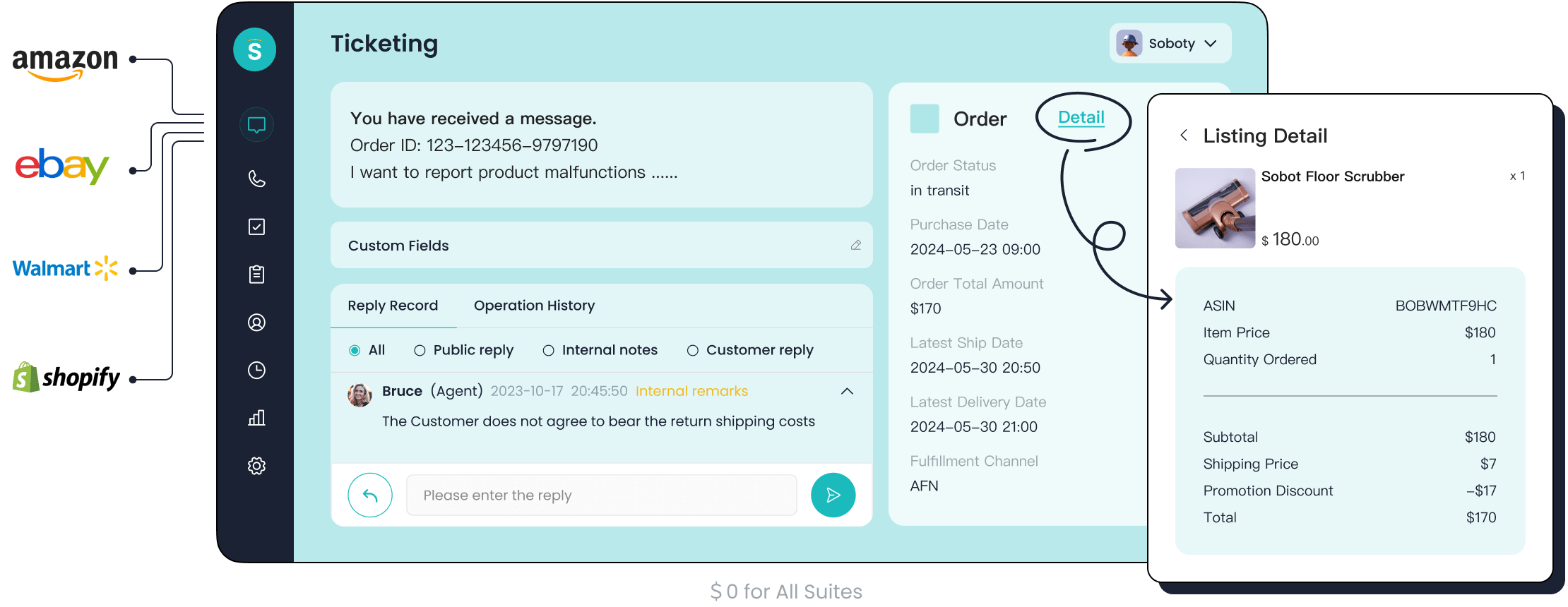What is a Ticketing System in Customer Support

A ticketing system in customer support helps you manage and track every customer request from start to finish. With a clear definition of ticketing, you see how each ticket moves through its lifecycle, making it easier to resolve issues quickly and improve customer service. Leading solutions like Sobot use automation and AI to reduce first response times and boost satisfaction scores. You gain insights into trends such as ticket volume, resolution time, and CSAT, which show how well your Sobot call center performs.
- A ticketing system helps you balance self-service and human support, automate routine tasks, and keep communication transparent.
Sobot AI ensures you never miss important details, helping your team deliver better results and happier customers.
Definition of Ticketing

What Is a Ticketing System?
When you look for the definition of ticketing in customer support, you find that a ticketing system is software that helps you track, manage, and organize every customer request. Each time a customer reaches out with a question or problem, the system creates a support ticket. This ticket gets a unique ID and stores important details like the customer’s contact information, the type of issue, its priority, and its current status. You can think of a support ticket system as a digital help desk that keeps everything in one place.
A modern ticketing system does much more than just collect requests. It centralizes all your communication, so you never lose track of a conversation. You can see every step taken to solve a problem, which brings transparency and accountability to your team. The system also lets you categorize and prioritize tickets, making sure urgent issues get attention first. This is the core definition of ticketing: a structured way to handle customer support from start to finish.
Tip: Using a support ticket system like Sobot helps you respond faster and keeps your team organized. You can automate many tasks, such as assigning tickets to the right agent or sending updates to customers.

Here is a table that shows the essential components of a ticketing system and how they help your business:
| Essential Component | Description | Benefits |
|---|---|---|
| Omnichannel Support | Combines email, chat, phone, and social media into one inbox. | Faster responses, better customer experience, and consistent service. |
| AI Capabilities | Uses chatbots, smart suggestions, and automatic ticket sorting. | Quicker answers, better routing, and more personal support. |
| Automation Features | Handles ticket routing, canned replies, and escalations automatically. | Less manual work, faster solutions, and easier scaling. |
| Customization Options | Lets you set custom ticket statuses, forms, and rules. | Workflows fit your needs and collect better data. |
| Knowledge Base Integration | Offers articles and search tools for self-service. | Fewer tickets, quicker answers, and consistent information. |
| Reporting and Analytics | Provides dashboards and reports to track trends and KPIs. | Data-driven decisions and proof of support value. |
| SLA Management | Tracks response and resolution times with alerts. | Reliable service and clear expectations. |
| Collaboration Tools | Enables internal notes, ticket sharing, and real-time updates. | Faster solutions for complex issues and better teamwork. |
| Mobile Support | Allows ticket management on mobile devices. | Quick responses anywhere and higher agent productivity. |
| Integration with Tech Stack | Connects with CRM, e-commerce, and other business tools. | Streamlined workflows and less data silos. |
You can see that a support ticket system is more than just a tool for logging problems. It is a complete platform that helps your help desk team work smarter and deliver better service.
How Support Tickets Work
When you use a support ticket system, every customer request becomes a support ticket. This ticket follows a clear path from creation to resolution. Understanding this process is key to mastering the definition of ticketing.
Here is how support tickets usually work:
- A customer sends a message through email, chat, phone, or another channel. The ticketing system automatically creates a support ticket and assigns it a unique ID.
- The system collects all the details, such as the customer’s name, contact info, and the nature of the problem. You can add notes, attachments, or screenshots to give more context.
- The support ticket system categorizes and prioritizes the ticket. For example, urgent issues get flagged for quick action, while less critical ones are scheduled for later.
- The system assigns the ticket to the right agent or team. With automation, this happens instantly based on rules you set, such as agent skills or workload.
- The agent works on the ticket, updating its status and communicating with the customer. All actions and messages are logged, so you always have a record of what happened.
- If the issue needs special expertise, the ticket can be transferred to another team. The system keeps ownership clear, so nothing gets lost.
- The ticketing system tracks deadlines and sends reminders to make sure nothing falls through the cracks.
- Once the problem is solved, the agent marks the ticket as resolved. The customer gets notified and can give feedback.
- The system closes the ticket, but you can always review its history for future reference or training.
Note: Automated ticketing systems like Sobot make this process smooth and efficient. You save time by letting the system handle repetitive tasks, such as routing and reminders. This means your help desk team can focus on solving problems, not managing paperwork.
Here is a simple ordered list to show the main steps in a support ticket’s journey:
- Ticket creation from customer query.
- Categorization and prioritization.
- Assignment to the right agent or team.
- Tracking and management with updates and logs.
- Resolution and closure with customer feedback.
- Reporting and analytics for continuous improvement.
A good support ticket system also helps you stay compliant with data protection laws. For example, Sobot’s platform includes features like secure data storage, audit trails, and role-based access. This keeps your customer data safe and helps you meet regulations such as GDPR.
You might wonder how automated ticketing compares to manual processes. Manual systems require agents to create and assign tickets by hand, which can be slow and error-prone. Automated systems, like Sobot, handle these steps for you. This leads to faster response times, fewer mistakes, and better service quality. You also get real-time dashboards and analytics, so you can spot trends and make smart decisions.
Did you know? Companies using automated support ticket systems report up to 30% higher agent productivity and much faster resolution times. Source: Sobot Official Website
The definition of ticketing is not just about tracking problems. It is about giving you the tools to deliver excellent customer service, keep your help desk organized, and make your business more efficient. With a support ticket system, you can handle more requests, respond faster, and keep your customers happy.
Customer Support Ticketing System
Ticket Lifecycle
A customer support ticketing system helps you track every step of a support ticket from start to finish. When a customer submits a request, the system creates a support ticket and assigns it a unique ID. You can see the journey of each ticket as it moves through different stages. This process is called the ticket lifecycle. Understanding this lifecycle helps you improve your issue resolution process and deliver better service.
Here are the most common stages in the lifecycle of a support ticket:
- Ticket creation: You receive a customer inquiry, and the system logs it as a new support ticket.
- Triage and prioritization: The customer support ticketing system analyzes the ticket and sets its urgency.
- Assignment: The system routes the ticket to the right agent or team.
- Investigation and diagnosis: The agent gathers information and finds the root cause.
- Resolution and implementation: The agent provides a solution to the customer.
- Customer verification and feedback: The customer checks if the solution works and gives feedback.
- Ticket closure and archiving: The support ticket system closes the ticket and stores it for future reference.
Sometimes, a ticket may get reopened if the customer needs more help. The customer support ticketing system keeps a record of every action, so you always know what happened. This clear path makes handling customer support tickets easier and more organized.
Tip: Using a help desk with a strong ticketing system, like Sobot, helps you automate these steps. You save time and reduce errors, which leads to faster solutions and happier customers.
Centralized Management
Centralized management is a key feature of any modern customer support ticketing system. When you use a centralized platform, you bring all customer inquiries into one place. This means you do not have to switch between tools or lose track of conversations. The customer support ticketing system acts as a single source of truth for your help desk.
Here are some ways centralized inquiry management improves your support operations:
- Omnichannel support lets you handle emails, chats, and social messages in one unified inbox.
- Automation and AI take care of repetitive tasks, such as ticket routing and sending quick replies.
- Collaboration tools, like internal comments and team mentions, help your agents share updates and solve problems together.
- Analytics and reporting give you insights to optimize your processes and allocate resources better.
- Organizing tickets by priority ensures urgent issues get solved first.
A customer support ticketing system like Sobot offers all these features. You can manage support tickets from multiple channels, automate assignments, and track every step in the help desk. This makes your team more efficient and improves the customer experience. With a centralized ticket management system, you keep all information in one place, making it easy to review past cases and learn from them.
Note: Centralized management not only streamlines your workflows but also boosts team collaboration. You can broadcast updates to all affected users and ensure nothing gets missed.
A strong customer support ticket system helps you handle customer support tickets quickly and accurately. You improve your help desk performance and make sure every customer gets the attention they need.
Sobot Ticketing System Features
Automation and AI
You can boost your support team’s productivity with Sobot’s automation and AI features. The automated ticketing system uses scenario-based AI that acts like a skilled employee, not just a basic chatbot. This AI handles routine questions, recommends products, and even triggers promotions at the right time. During busy periods, the AI keeps response times low, even if inquiries surge by 200%. You get 24/7 support for your customers, so no one waits for help. Sobot’s AI also works with your agents, letting them focus on complex problems while the system manages simple tasks. This approach saves about 54% of resolution time and increases conversions by over 30%. Major brands like Samsung and OPPO trust Sobot for these advanced features.
Tip: With automated routing of tickets, you make sure every request goes to the right person without delay.
Multichannel Integration
Sobot’s ticketing system brings all your customer conversations into one place. You can manage emails, live chat, phone calls, and even social media messages from a single dashboard. This unified customer support platform means you never miss a message, and your team stays organized. The system also connects with e-commerce platforms like Shopify, so you can track orders and support requests together. By merging all channels, you give customers the freedom to reach you how they want, while you keep every ticket in one stream.
Here are the most common channels you can integrate:
- Email support
- Web forms
- Phone support
- Live chat
Note: Multichannel integration helps you avoid data silos and improves your team’s efficiency.
SLA and Analytics
Sobot’s ticketing system gives you powerful tools to track and improve your support performance. You can set Service Level Agreements (SLAs) to make sure your team responds and resolves tickets on time. The system uses AI Insight dashboards to show you key metrics like response times, agent workload, and customer satisfaction. These data-driven insights help you spot trends, find bottlenecks, and make smart decisions. You can also analyze ticket types and frequency to see what issues come up most often. This helps you plan resources and improve your service.
| Feature | Benefit |
|---|---|
| SLA Management | Ensures timely responses and resolutions |
| Analytics Dashboard | Tracks trends and team performance |
| Reporting Tools | Provides data-driven insights |
Sobot’s multilingual support lets you serve customers in many languages, making global support easy and accurate.
Benefits of a Customer Support Ticket System

Faster Response
You want your customers to get help quickly. A customer support ticket system gives you the tools to deliver faster response times. When a customer sends a request, the system creates a ticket and assigns it to the right agent. Automation handles ticket routing and prioritization, so no issue waits in a queue for too long. With Sobot, you can set up rules that send urgent tickets straight to the right team. This means your customers do not have to wait for answers.
90% of customers say immediate responses are important for customer service. A ticketing system helps you meet this expectation by reducing delays and making sure every inquiry gets attention. Source
You also save time with features like canned responses and AI-powered suggestions. These tools let your agents reply faster and more accurately. As a result, you build trust and loyalty with your customers.
Improved Tracking
Tracking every customer request is easier with a ticketing system. You see all tickets in one place, so nothing gets lost. The system logs every action, from the first message to the final resolution. This communication tracking helps you review past cases and learn from them.
Here is how a ticketing system improves tracking and resolution:
- Centralized logging keeps all support requests organized.
- Categorization and prioritization make assignment and resolution simple.
- Collaboration tools let your team share updates and solve problems together.
- Seamless channels allow customers to submit requests and get updates easily.
- Reporting and analytics show you trends and help you improve your customer service.
Sobot’s platform gives you dashboards and analytics to monitor ticket status and agent performance. You can spot patterns, find bottlenecks, and make better decisions for your support team.
Enhanced Customer Experience
A customer support ticket system leads to enhanced customer experiences. Customers feel valued when you respond quickly and solve their problems the first time. The system ensures consistent support quality by standardizing workflows and keeping records of every interaction.
You can personalize support because the system stores customer history and preferences. Sobot’s multilingual support and self-service options make it easy for customers to get help in their own language or find answers on their own. This approach increases satisfaction and encourages repeat business.
Customers who receive timely customer support are more likely to stay loyal and recommend your brand to others.
With a ticketing system, you also reduce operational costs. Automation and centralized management mean your team works more efficiently, and you need fewer resources to handle the same number of requests. This efficiency helps you scale your customer service as your business grows.
Choosing a Support Ticket Solution
Integration and Scalability
When you choose a ticketing system, you need to think about how well it fits with your current tools and how it can grow with your business. A good ticketing system should connect with your CRM, knowledge base, and reporting tools. This way, you can see customer data, past conversations, and helpful articles all in one place. You also want to make sure your system works with team collaboration tools like Slack or Microsoft Teams. This helps your agents work together and solve problems faster.
Here are some important integration options to look for:
- CRM integration to view customer history and billing details inside each ticket.
- Knowledge base integration so agents can find answers quickly.
- Reporting and analytics tools to track team performance and customer satisfaction.
- Team collaboration tools for better teamwork.
- Asset management and ITSM integrations for internal support.
- Automation through APIs and webhooks for custom workflows.
- Omnichannel integration to manage emails, chats, and calls in one dashboard.
A scalable ticketing system lets you add new channels and features as your business grows. Sobot’s ticketing system supports all these integrations, making it easy for you to expand your support operations without switching platforms.
User-Friendliness
You want a ticketing system that is easy for your team to use. A simple and clear interface helps agents learn quickly and handle more tickets with less training. Automation features, like auto-routing and canned responses, save time and reduce mistakes. When your agents can focus on helping customers instead of managing software, everyone wins.
User-friendly systems offer:
- Easy ticket creation and assignment.
- Clear workflows for tracking and resolving issues.
- Automation that sends tickets to the right person.
- Reporting tools to help you improve your process.
- AI-powered features that sort and prioritize tickets.
Sobot’s ticketing system gives you all these benefits. Agents can manage tickets from any device, and the system’s automation reduces manual work. This leads to faster responses and happier customers. Companies that use user-friendly ticketing systems often see a big drop in resolution times and higher customer satisfaction.
Real-World Example: OPPO and Sobot
Let’s look at how OPPO improved its customer service with Sobot’s ticketing system. OPPO faced a huge increase in customer questions during busy shopping seasons. By using Sobot’s AI-powered ticketing system, OPPO handled routine questions with chatbots and let human agents focus on complex issues. This mix of automation and human support helped OPPO cut maintenance work by 90% and reach an 83% chatbot resolution rate. Customer satisfaction jumped to 94%, and the repurchase rate increased by 57%. These results show how a modern ticketing system can boost efficiency and customer happiness.
Tip: When you choose a ticketing system like Sobot, you get a platform that grows with your business and makes support easier for both your team and your customers.
Understanding a customer support ticketing system helps you deliver better service and keep customers loyal. Companies that use unified ticketing see up to 26% higher retention rates by making support faster and more organized. Sobot’s platform lets you automate tasks, track every request, and improve satisfaction. To get started:
- Map your customer journey and spot automation opportunities.
- Choose a tool like Sobot with omnichannel support and AI features.
- Test, refine, and expand your system as your needs grow.
Visit Sobot’s website or contact the team to explore a smarter customer support ticketing system for your business.
FAQ
What is a customer support ticketing system?
A customer support ticketing system helps you track, manage, and resolve customer requests. You can organize every inquiry as a ticket. This system keeps your support team efficient and ensures no request gets missed. Sobot’s ticketing system offers automation and analytics for better results.
How does a ticketing system improve response times?
You get faster responses because the ticketing system automatically assigns tickets to the right agent. Automation handles routine tasks. Sobot’s platform reduces manual work and helps your team reply quickly. Studies show automated systems can boost agent productivity by up to 30% (source).
Can I manage tickets from different channels in one place?
Yes! A customer support ticketing system like Sobot lets you handle emails, chats, phone calls, and social media messages in one dashboard. You never have to switch between tools. This unified approach improves your workflow and keeps all customer support tickets organized.
What features should I look for in a customer support ticketing system?
Look for these features:
- Omnichannel support
- Automation and AI
- SLA management
- Analytics and reporting
- Multilingual support
Sobot’s customer support ticketing system includes all these features, making it easy for you to deliver excellent service to every customer.
Is a customer support ticketing system secure?
You can trust a modern customer support ticketing system to keep your data safe. Sobot uses secure data storage, role-based access, and audit trails. These features help you meet privacy regulations and protect customer information.
Tip: Always choose a ticketing system with strong security and compliance features.
See Also
Expert Techniques To Excel At Live Chat Support
The Leading Customer Service Software Solutions In 2024
How AI Agents Are Transforming Customer Support Today
